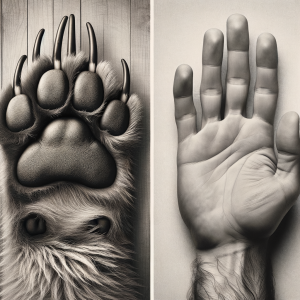Bear Paw vs Human Hand: Understanding the Differences
Comparing the bear paw to the human hand is a fascinating study that sheds light on the similarities and differences between these two appendages. Understanding this comparison is crucial for gaining insights into the evolutionary adaptations and functional differences between bears and humans.
Discover the Surprising Size Comparison Between Bear Paws and Human Hands
Find out just how much larger a bear paw is compared to a human hand, and be amazed by the fascinating size differences between these two species.
Bear Paw Characteristics
When comparing the bear paw to the human hand, it’s important to consider the unique characteristics of each.
Size and Dimensions
The bear paw is significantly larger and wider than the human hand, with an average length of 7.9-9.8 inches (20-25 cm) for adult bears, compared to the average human hand length of 6.7-7.8 inches (17-20 cm).
Physical Features
The bear paw is equipped with sharp claws, which are essential for hunting, climbing, and self-defense. The pads on the bear paw provide traction and insulation, allowing bears to navigate various terrains and climates.
On the other hand, the human hand lacks claws and has a more dexterous structure, with opposable thumbs that enable precise grip and manipulation of objects.
Overall, the bear paw’s size and physical features are adapted for survival in the wild, while the human hand is specialized for complex tasks and tool use.
Human Hand Characteristics
When comparing the bear paw to the human hand, it is essential to understand the unique characteristics of the human hand. Here are some key points to consider:
A. Size and dimensions
The average adult human hand measures approximately 7.6 inches (19.3 cm) in length from the tip of the middle finger to the wrist. The span of the hand, from the tip of the thumb to the tip of the pinky finger, is around 7.4 inches (18.8 cm).
B. Physical features
The human hand is characterized by opposable thumbs, allowing for precision grip and manipulation of objects. It consists of five fingers, each with unique dexterity and sensitivity, enabling a wide range of movements and functions.
Overall, the human hand is a remarkable tool that has evolved to perform intricate tasks and activities, making it distinct from the bear paw in several ways.
 Comparison of Bear Paw and Human Hand
Comparison of Bear Paw and Human Hand
When comparing the bear paw to the human hand, several key differences and similarities become apparent. Understanding these comparisons is essential for gaining insight into the unique characteristics and functionalities of each.
Size Comparison
One of the most striking differences between the bear paw and the human hand is their size. The bear paw is significantly larger, with an average length of 10 inches (25.4 cm) for an adult grizzly bear, compared to the average human hand length of 7.6 inches (19.3 cm). Additionally, the bear paw is wider and more robust, with larger and stronger claws, making it a formidable tool for hunting and defense.
Physical Features Comparison
Physically, the bear paw and human hand also differ in several ways. The bear paw is covered in thick fur and has a thick layer of fat underneath, providing insulation and protection in harsh environments. In contrast, the human hand has a thinner layer of skin and lacks the fur and fat insulation found in bear paws. Additionally, the bear paw has a more pronounced muscle structure, allowing for greater strength and dexterity in gripping and manipulating objects.
Understanding these differences in size and physical features is crucial for appreciating the unique adaptations and functionalities of both the bear paw and the human hand. By comparing these characteristics, we can gain a deeper understanding of the evolutionary traits that have shaped these remarkable appendages.
Behavioral and Functional Differences
When comparing the bear paw to the human hand, it is essential to consider the behavioral and functional differences between the two.
Differences in Functionality
The bear paw, with its large size and powerful claws, is primarily used for activities such as hunting, climbing, and digging. In contrast, the human hand, with its opposable thumb and fine motor skills, is adapted for tasks such as grasping, manipulating objects, and intricate movements.
Behavioral Adaptations
Bears rely on their paws for survival in the wild, using them for activities such as catching prey, defending themselves, and foraging for food. On the other hand, human hands are integral to various cultural, social, and occupational activities, including communication, tool use, and artistic expression.
Understanding these differences in functionality and behavioral adaptations provides valuable insight into the unique characteristics of the bear paw compared to the human hand.
Geographic Distribution
Understanding the geographic distribution of bear paw compared to human hand habitats is essential in gaining a comprehensive understanding of these species.
Bear Paw Habitats
Bear paws are primarily found in forested areas, including temperate, subarctic, and arctic regions. These habitats provide the necessary resources for bears to thrive, including food sources and shelter.
Human Hand Habitats
Human hands, on the other hand, are not restricted to specific habitats. They are found in various environments across the globe, ranging from tropical rainforests to arid deserts and urban areas.
By comparing the geographic distribution of bear paws and human hands, we can gain insights into the adaptability and versatility of the human species in contrast to the more specific habitat requirements of bears.
Conclusion
After comparing the bear paw and human hand, it is evident that while there are similarities in some aspects, there are also significant differences that are important to understand. The comparison provides valuable insights into the adaptations and functionalities of these appendages, shedding light on the unique characteristics of each.
Understanding the differences and similarities between the bear paw and human hand is crucial for various reasons:
- It allows for a deeper appreciation of the evolutionary adaptations that have shaped these appendages over time.
- It provides valuable knowledge for fields such as biology, zoology, and anthropology.
- It offers insights into the behavioral and functional differences between humans and bears.
By recognizing the distinct features and functionalities of the bear paw compared to the human hand, we gain a better understanding of the natural world and our place within it. This knowledge can also inform conservation efforts and help us coexist harmoniously with wildlife in their respective habitats.
Overall, the comparison serves as a comprehensive guide to the unique characteristics of the bear paw and human hand, offering valuable insights for a broad audience interested in learning about these fascinating appendages.


Comments are closed.